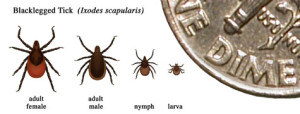It’s time for summer camp! Here are 6 easy tips for tick safety and Lyme disease prevention this season.
As staffers, parents and kids prepare for another memorable summer at camp, there is one important detail that must not escape our attention – doing everything possible to ensure that children are protected from the blacklegged ticks that transmit Lyme disease.
Lyme disease is the most common vector-borne illness in the U.S., with more than 329,000 new cases every year. These tiny ticks, no larger than a poppy seed, are active all year round, but they’re out in force during the summer months.  Unsurprisingly, children are at particular risk for tick bites, especially as they spend time outdoors at camp. Unfortunately, these “nymphs” are so tiny, they’re often difficult to spot.
Unsurprisingly, children are at particular risk for tick bites, especially as they spend time outdoors at camp. Unfortunately, these “nymphs” are so tiny, they’re often difficult to spot.
So, here are some suggestions to help protect campers and staff from tick-borne diseases:
- Know where ticks live. Ticks thrive in shady, wooded areas, taller grasses and leaf piles. When you plan outdoor activities, avoid having kids lean against tree trunks, sit on grass or on fallen logs. Ask campers to stay in the middle of hiking paths to avoid brushing against foliage and long grasses.
- Recommend tick-repellent clothing. While children are at camp, it is strongly recommended they wear clothing treated with permethrin, an insecticide that repels and kills ticks and mosquitos on contact. Its formula is safe and EPA-approved, and can be used on clothing worn by children. Parents can spray it on their child’s clothes at home or can purchase pre-treated clothing and gear with the Insect Shield label from retailers such as LL Bean or REI. Parents can also send clothing directly to Insect Shield to be treated.
- Don’t forget to spray shoes. Since most ticks crawl onto people from the ground, spraying closed-toe footwear with permethrin is one of the best defenses against ticks. (One study found that those with treated shoes had 74% fewer tick bites that those with untreated shoes).
- Make sure campers use repellent on exposed skin. Studies show that EPA-approved repellents containing 20%-30% DEET, 20% Picaridin or 30% natural Lemon Eucalyptus oil are the most effective.
- Do full body tick checks. Tick bites are painless so it’s important for campers to perform regular tick checks after being outdoors and at night before bedtime. Teach campers to pay particular attention to areas between the toes, behind the knees and ears, armpits, groin, belly button, neck, hair and scalp.
- Know what symptoms to look for. Camp nurses and counselors should look for flu-like symptoms following a tick bite. Staff should also be sure to check smaller children for ticks and signs of Lyme.
This post, written by Scott Santarella, CEO, Global Lyme Alliance was first published by the American Camp Association. For more information about ticks and other tick-bourne illnesses, check out the ACA’s Ticks – What Every Camp Needs to Know.

GLA
Admin at GLA
